Ten best of Chinese Works of Art @ Sotheby's New York
A Fine Pair Of 'Huanghuali' Yokeback Armchairs (Guanmao Yi), 17th Century. photo Sotheby's
The various owner sale of Fine Chinese Ceramics and Works of Art achieved a total of $25,968,650 (est. $9.2/13.1 million), Sotheby’s highest total in this category since the March 2007 sale which included highlights from the Albright-Knox Art Gallery. The sale was led by A Fine Pair of ‘Huanghuali’ Yokeback Armchairs (Guanmao Yi), 17th Century which sold for $2,770,500, several times the $200/300,000 estimate. The highlight of the paintings in the sale was An Important Imperial Nian Rebellion Battle Painting Qing Dynasty, Guangxu Period which was fought after by five bidders before selling for $1,986,500, well over the estimate of $800,000/1.2 million. A strong group of jades included A Rare Imperially Inscribed Celadon Jade Archaistic Vessel And Cover (Yi), Qianlong Fanggu Mark And Period from the Collection of Robert Tod which sold for $1,650,500 several times the $70/90,000 estimate. The porcelain in the sale was led by A Rare ‘FamilleRose’ Reticulated Revolving Vase, Qianlong Seal Mark and Period which sold for $1,202,500, well over the $400/500,000 estimate.
A Fine Pair Of 'Huanghuali' Yokeback Armchairs (Guanmao Yi), 17th Century. photo Sotheby's
each finely carved of spare form, the undulating bow-shaped toprail with flattened headrest and rounded terminals, supported on a bowed splat and tapered stiles, extending to S-shaped armrails held by the curved front posts with lobed brackets and mid-section support, the front and back posts continue through the rectangular cane seat to form the legs of square section, set with simple beaded aprons in the front and plain aprons on the side, the legs held by box-stretchers with a flattened foot rest with simple apron attached to the front, rounded square stretchers with aprons on the sides and a plain square stretcher along the back (2); 25 1/4 x 46 1/4 x 25 3/4 in., 64.1 x 117.5 x 65.4 cm. Estimate 200,000—300,000 USD. Lot Sold 2,770,500 USD to an Asian Buyer
PROVENANCE: Peter Lai Antiques Ltd., Hong Kong.
NOTE: The present pair of yokeback armchairs is exceptional for the large size and the understated elegance of the softly curving stretchers. Such armchairs were among the most prestigious chairs in a traditional household and belong to the type known as guanmao yi ('official's hat chair'), referring to the resemblance of the crestrail to the extended wings characteristic of headdresses worn by oficials.
For a discussion of yokeback armchairs, see Curtis Evarts, 'From Ornate to Unadorned', Journal of the Chinese Classical Furniture Society, Spring 1993, pp. 24-33.
An Important Imperial Nian Rebellion Battle Painting ‘Siege of Pingyu,’ Qing Dynasty, Guangxu Period. photo Sotheby's
ink and colour on paper, framed and under glass; 122 x 54 in., 309.9 x 137.1 cm. Estimate 800,000—1,200,000 USD. Lot Sold 1,986,500 USD to an Asian Trade.
one painting from a set of eighteen, depicting the siege of the fortified city of Pingyu in western Henan province, occupied by the Nian rebels under the local Nian rebel leader Chen Daxi, engaged in a fierce battle with the Qing Imperial army in their efforts to regain control of the city, the Nian rebels behind the high walls built around the city and further fortified with a deep moat, the rebels with distinctive orange-red headscarves, their flags of yellow, white, red, blue and black high above the gates, the Imperial army on stocky horses, the locally recruited infantry of the Imperial army wearing uniforms of red, blue and white corresponding with the banners of the Imperial army, all armed with swords, spears, muskets, bows and arrows charging toward the city walls, storming them and attacking the rebels inside the walls, all under the leadership of a number of named generals, among them Zheng Yuanshan, Zhang Yao, Wu Yuanbing, Yin Jiabin and Sheng Bao
NOTE: This impressive painting belongs to a set of eighteen paintings depicting commemorative battle scenes between the Qing Imperial Army and the rebel forces of the Nian. Led by the charismatic leader Zhang Lexing, the Nian rebellion was an armed uprising that took place in northern China from 1853 to 1868, contemporaneously with the Taiping Rebellion (1851–1864) in southern China. The Nian forces fortified their captured cities and used them as bases to launch cavalry attacks against Qing troops in the countryside, prompting local towns to fortify themselves against Nian raiding parties. This painting is the seventh painting in the set and shows the siege and subsequent regaining of the city of Pingyu in western Henan province, in 1862 under the leadership of several important figures n the Qing Imperial military and civil forces, among them high-ranking and meritorious figures such as Wu Yuanbing and Yin Jiabin, Zheng Yuanshan and Zhang Yao, pictured on horseback looking straight at the viewer. All of them had been involved in pacifying unrests in surrounding villages before the victorious battle at Pingyu. For a more detailed account of this battle, compare Nian Jun Shi, Shanghai, 2001, pp. 309-310.
The painting was created as part of a large-scale Imperial painting project commissioned in 1885 by the Guangxu emperor to commemorate the government victories over the three major Chinese 19th century rebellions: the Taiping Rebellion, the Nian Rebellion and the Muslim Rebellions. A total of sixty-seven paintings each of similar large size and intricate details, were painted. They comprised twenty paintings for the Taiping War, eighteen for the Nian Rebellion, twelve for the Muslim rebellion in Yunnan and Yuizhou, and seventeen paintings for the Muslim rebellion in the northwestern borders. Compare Hongxing Zhang, in 'Studies in Late Qing Dynasty Battle Painting', Artibus Asiae, vol. LX, no. 2, 2000, p. 267.
The paintings were made for the the Ziguang Pavilion (Hall of Purple Splendour), a two-storey building on the western shores of the Central Lake in Zhongnanhai, located west of the Forbidden City. Just a century earlier, during the reign of the Qianlong emperor, the emperor would receive foreign envoys in this pavilion and celebrate the victories of his Ten Great Military campaigns. It was also where portraits of meritorious banner officers and large-scale paintings of battles commemorating Qianlong's military victories were displayed.
Only a very small number of paintings of the original sixty-seven Guangxu battle paintings have survived. A complete set of twelve paintings depicting scenes of the Muslim Rebellion in Yunnan and Yuizhou are in the Palace Museum, Beijing, illustrated in Hongxing Zhang, in 'Studies in Late Qing Dynasty Battle Painting', Artibus Asiae, vol. LX, no. 2, 2000, figs. 5 and 6. Three other paintings from the series commemorating victorious battles between the Imperial army and the forces of the Taiping Heavenly Army are known, one sold at Christie's London, 22nd April 1991, lot 101, two in our Hong Kong rooms, 9th October 2007, lot 1312, and 8th October 2009, lot 1660; another painting from the series commemorating the victories over the Muslim in the Northwest, was sold in our New York rooms, 15th September 2010, lot 367.
Of the eighteen paintings commemorating the Imperial campaign against the Nian rebels only two examples are known, both now in the National Gallery, Prague; the first depicting the defeat of the troops of the chief rebel Zhang Minhang in Shandong province in October 1861, the second the triumphant procession of government troops which concluded the campaign in August 1868, both published by Hongxing Zhang in 'Studies in Late Qing Dynasty Battle Painting', Artibus Asiae, vol. LX, no. 2, 2000, figs. 2 and 3.
A Rare Imperially Inscribed Celadon Jade Archaistic Vessel and Cover (Yi) Qianlong Fang Gu Mark and Period. photo Sotheby's
the elongated ewer of oval section resting on a high foot, the gently sloping cover over a long curved spout set with a pair of prominent horns above a stylized taotie mask at one end and a taotie mask at the other end, with a hollow finial studded alternately with beads of blue and red, the hinged cover attached to a handle carved in the form of a stylized dragon, the cover finely incised on the underside with a 40-character inscription, with a Qianlong period bingshen year date corresponding to 1776, and two small seals guxiang and taiyu, finely carved around the body with an archaising design of interlocking hooks and spirals, the countersunk base with the six-character mark Da Qing Qianlong Fang Gu ('Made in the Qianlong era of the Great Qing in imitation of antiquity'), the stone of even pale celadon-white tone, wood stand (2); width 6 in., 15.3 cm. Estimate 70,000—90,000 USD. Lot Sold 1,650,500 USD to an Asian Trade
NOTE: The inscription incised on the inside cover is the poem by the Qianlong emperor titled Yong Hetian yu kuiyi ('Song for a Hetian Jade kuiyi Vessel') and may be translated as follows:
Many ancient vessels are cast in bronze,
But now here is an yi vessel made of polished jade.
Its spreading handle accords with Zhou conventions,
A fit companion to a cauldron in sacrificial ceremonies.
Its inscription may differ from the one on "Foster Mother (yi)",
But as a treasure conferred it surpasses "Lady Wen (yi)."
One might scoff at the new way it looks,
But such hullabaloo would be just a waste of time.
Composed by the Qianlong emperor in the spring of the bingshen year (corresponding to 1776). Two seals reading guxiang and taiyu.
The poem is recorded in the Qing Gao Zong yuzhi shiwen quanji, 4 ji, quan 37.27.
The present vessel is based on an archaic bronze guang, one of the rarest and most coveted of archaic bronze forms. As the inscription finely incised on the base of the vessel reveals, it was made 'in imitation of antiquity' (fang gu), its shape and design successfully combining an archaic form with contemporary style. In response to emperor Qianlong's fascination with the past, craftsmen in the Imperial workshops drew inspiration from the Xiqing gujian (Mirror of Antiquity of the Western Qing), the 40-volume catalogue of the imperial Qing bronze collection, of 1751. Compare, for example, a comparatively plain bronze guang, illustrated in Xiqing gujian, juan 32.36a.
Several jade guang vessels are in the former Imperial collection, compare two related examples, illustrated in The Refined Taste of the Emperor: Special Exhibition of Archaic and Pictorial Jades of the Ch'ing Court, Taiwan, 1997, cat. nos. 13 and 20. Compare another jade guang, published in The Complete Collection of Treasures of the Palace Museum, Hong Kong, 1995, no. 139. Compare also a jade guang similarly inscribed with an Imperial poem, and also bearing a Qianlong fang gu mark, sold in these rooms, 19th March 2007, lot 8.
A Very Rare And Well-Carved 'Hundred Boys' Celadon Jade Brushpot, Qing Dynasty, 18th Century. photo Sotheby's
of wide cylindrical form supported on five evenly spaced ruyi-form feet, the exterior skillfully carved and undercut in deep relief with a continuous scene of boys at play in a garden landscape, one side carved with five boys in a procession marching towards a pavilion, one carrying a vase with millet sprays, one on a hobby horse, another playing with fire crackers, two more waving a banner, and one carrying a lantern, the other side further carved with six boys in a balustraded garden playing various musical instruments including a drum, a pipe, cymbals, and a gong, all within a rock garden with towering pine and plantain trees and beneath a band of wispy scrolling clouds carved along the mouthrim, the stone a pale celadon tone with some calcified white flecks, elaborately carved wood stand (2); height 5 3/4 in., 14.8 cm. Estimate 300,000—400,000 USD. Lot Sold 1,538,500 USD to an American Private
NOTE: Celadon jade brushpots of this size are rare due to the limited supply of the material. The superb quality of the carving reflects the preciousness of jade and is a fine example of the very high standard of carving achieved during the 18th century at the Qing court.
The present lot is decorated with the subject of the 'Hundred Boys', a popular motif in the decorative repertoire of the Ming and Qing dynasties as it symbolizes the Chinese perpetual wish for many sons. According to Terese Tse Batholomew in Hidden Meanings in Chinese Art, San Francisco, 2006, p. 63, the 'Hundred Boys' theme has its origins in the Western Zhou dynasty when King Wen of the Zhou adopted one son in addition to his ninety-nine sons to complete the number of one hundred.
Although the 'Hundred Boys' theme was popular in porcelain decoration, it is rare to find a jade brushpot carved with this subject matter. Rare examples include a brushpot formerly in the Imperial collection and now in the collection of the National Palace Museum in Taipei, illustrated in The Refined Taste of the Emperor: Special Exhibition of Archaic and Pictorial Jades of the Ch'ing Court, Taipei, 1997, no. 59, also carved with boys at play but of square cross-section.
A Rare 'Anhua' Decorated White Glazed Ewer, Ming dynasty, Yongle Period. photo Sotheby's
the generous pear-shaped body supported on a short splayed foot, incised with a large continuous lotus flower scroll below an upright ruyi-head border, all beneath the flared mouthrim encircled by a meandering floral scroll, the tapering spout linked to the neck by a scrolling cloud-form strut further incised with a smaller floral scroll, the elegantly arched handle decorated with a leafy undulating scroll, surmounted with a small circular loop for attachment, the top and base of the handle mounted with silver brackets inlaid with ruby and white glass beads; height 12 1/2 in., 32 cm. Estimate 400,000—600,000 USD. Lot Sold 1,258,500 USD to a Private Collector
In the style of Lang Shining (Giuseppe Castiglione), 'The Fragrant Concubine,' Qing Dynasty, 18th / 19th Century. photo Sotheby's
Oil on paper, framed; 27 by 19 1/2 in., 68.6 by 49.5 cm. Estimate 100,000—150,000 USD. Lot Sold 1,202,500 USD to an Asian Trade
PROVENANCE: Collection of William Haynsworth.
Sotheby's New York, 9th and 10th October 1987, lot 40.
NOTE: Few female subjects in the Chinese painting repertoire of the Qing dynasty have summoned the level of curiosity and myth-making as the woman seated in the present picture. Elegantly attired and gazing directly at the viewer, the young woman seated has inspired grand theories as to her identity and origins. In her most popular incarnation, she is known as the 'Fragrant Concubine'.
The legend of the 'Fragrant Concubine' appears have developed as a result of historical fact embellished with fanciful myths. Historically, it is believed that her name was Rong Fei, a Muslim of Uighur descent from the oasis city of Kashgar in Xinjiang province. In 1760 she entered the Imperial harem in Beijing as a sixth-ranked guiren or honored person. She lived in the Imperial palace until her death in 1788, by which time she was promoted to the fourth rank of fei, or consort. The 'Fragrant' mythology stems from the story of Qianlong's discovery of Rong Fei. Although her beauty was unsurpassed, it was her body's natural scent that the Emperor found captivating.
The present painting belongs to a genre that has fascinated scholars and collectors alike and can be traced to a related painting from the collection of Madame Chiang Kai-shek, published in Cecile and Michel Beurdeley, Giuseppe Castiglione: A Jesuit Painter at the Court of the Chinese Emperors, Fribourg, Switzerland, 1971, cat. no. 83. Madame Chiang's painting is attributed to Castiglione, and said to have been commissioned by the Qianlong emperor as a tribute to his favorite consort. The present painting depicts the woman in a sumptously embroidered blue robe, whereas the related painting features the sitter in a red robe. It is possible that the present painting was a version of the purported original.
For an example of another painting in this genre, attributed to the mid-19th century and laid down on canvas, see one sold at iGavel, 5th May 2010, no. 1773053.
The foundation of Jesuit-style influence in the painting is apparent in the careful shading of the woman's face. Contrast the fleshiness of her face with another portrait of one of Qianlong's concubines, illustrated in Paintings by the Court Artists of the Qing Court: The Complete Collection of Treasures of the Palace Museum, Hong Kong, 1996, pl. 45, p. 201, where the woman's face is painted employing the traditional Chinese method of 'fine-line' painting.
A Rare 'Famille-Rose' Reticulated Revolving Vase, Qianlong Seal Mark and Period. photo Sotheby's
the pear-shaped revolving body painted with formal lotus scrolls reserved on a pale-blue sgraffiato ground, further reticulated with four evenly spaced gilt-rimmed medallions, each containing a puce-enameled dragon writhing amidst scrolling green clouds, all below a yellow-ground waisted neck painted with alternating bats and lotus flowers below a raised ring and a band of upright lappets beneath the keyfret bordered mouthrim, the angular shoulder further encircled by blue and orange wan-symbols border, all supported on a similarly decorated waisted foot, the inner cylindrical body painted with the wufu flying amidst tall bamboo and flowering camellia wreathed in clouds ; height 8 1/4 in., 21 cm. Estimate 400,000—500,000 USD. Lot Sold 1,202,500 USD to an Asian Private
NOTE: Technical innovation and finesse in porcelain production were both expected and encouraged during the Qianlong emperor's reign. Therefore it is not surprising that revolving vases appear to have been introduced during this time, under the supervision of Tang Ying, the ingenious supervisor of the imperial factory, who raised the standard of Jingdezhen porcelain to its highest level. Revolving vases such as the present lot are amongst the most complicated porcelain produced in Jingdezhen and would have been the perfect demonstration of the technical virtuosity of the craftsmen at Jingdezhen.
Revolving vases can be found in several important collections, including one with a very similar design but of a slightly different form in the Palace Museum collection, illustrated in The Complete Works of Chinese Ceramics, Shanghai, 2000, pl. 23. See also a blue-ground revolving vase from the National Palace Museum featuring pink dragons and illustrated in Stunning Decorative Porcelain from the Ch'ien-lung Reign, Taipei, 2008, no. 77.
A Fine and Rare Blue and White Double-Handled Vase, Jiajing Mark and Period. photo Sotheby's
the superbly potted body of compressed pear-shape, painted in a rich underglaze-blue with a pair of confronted dragons beneath stylized interlocking scrolls, a keyfret border set between two raised bands, flanked by a pair of loop handles springing from monster masks and set with loose-rings, both decorated with leaf motifs, the flared neck with further interlocking scrolls, all above a stepped and slightly splayed foot encircled by ruyi and scroll bands, the blue of vibrant and rich tone, the six-character Jiajing mark on the galleried rim; height 7 in., 17.7 cm. Estimate 250,000—300,000 USD. Lot Sold 1,052,500 USD to Shanghai Tianwuguan Art Fund
PROVENANCE: Higuchi Family Collection.
Osaka Bijutsu Club auction, 3rd June 1931, no. 66.
Yamauchi Family Collection.
Kyoto Bijutsu Club auction, 21st January 1935, no. 196.
NOTE: The present vase belongs to a group of small blue and white vases which derived from larger prototypes dated to the Yuan and early Ming dynasty. For an example of a larger vase of related form made during the late Yuan dynasty, see Jessica Harrison-Hall, Ming Ceramics in the British Museum, London, 2001, pl. 1:42. Harrison-Hall further speculates that vases of this shape were based on ancient bronze hu vessels, where the angular mouth and handles would be more appropriate.
By the Jiajng period, porcelain production was more advanced, which allowed for more delicate potting and intricately painted designs, making it possible for these vases to be made in smaller forms, such as the present lot. A very similar example painted with phoenix birds in the Palace Museum collection, is illustrated in Blue and White Porcelain with Underglazed Red (I), The Complete Collection of Treasures of the Palace Museum, Hong Kong, 2000, pl. 89. See also a vase of the same shape without loose-ring handles dated to the Zhengde period in the British Museum, op. cit., pl. 8:18. Three further related examples of slightly larger sizes are in the National Palace Museum, Taipei, illustrated in Porcelain of the National Palace Museum: Blue-And-White Ware of the Ming Dynasty, Hong Kong, 1963, pls. 6, 7 and 8
A Rare 'Famille-Rose' Figure of Amitayus, Qing Dynasty, 18th/19th Century. photo Sotheby's
seated in dhyanasana on a triangular waisted lotus base with hands held in dhyanamudra supporting a vase with a cintamani emblem, the face with serene expression, the hair enameled blue and partially falling over the shoulders, the rest swept into a high topknot and secured by an ornamental jewel worn behind the five-leaf diadem, the shoulders draped with a billowing shawl wrapped around the lower arms, the bare chest adorned with jeweled necklaces, the robe in pale blue, red and lime green enamels decorated with scrolling lotus and floral roundels, the detachable base enameled with tiers of lotus petals, with the tips of the scarf falling over the front, wood stand (4); height 11 3/8 in., 29 cm. Estimate 80,000—120,000 USD. Lot Sold 962,500 USD to a Private Collector
NOTE: The Amitayus is always shown in dhyana mudra and with an amrita-kalasha, the vase of long life, filled with ambrosia, nectar pills which confer immortality. The flame emanating from the lotus at the rim of the vase refers to his emanation of the fire element, symbolized by the Buddha Amitabha. The Amitayus Buddha is invoked to cure illness and after death, the hope to be transported to the world of Amitabha who resides in the Western Paradise.
The adoration of brightly colored deities has a long tradition in Tibetan Buddhism and the wide color range available in the famille-rose palette made porcelain an ideal medium to create such Buddhist figures. Nevertheless, these figures remain extremely rare and it is likely that they were especially made on special commission.
It is rare to find these devotional figures with naturalistically toned flesh rather than gilt. There is an identically modeled and painted figure of slightly smaller size in the British Museum dated to the 18th century and donated to the museum in the 19th century by Sir Augustus Wollaston Franks (1826-1897).
A similar example but with gilt decoration was sold in our Paris rooms, 16th December 2010, lot 196.
A Rare 'Ru'-Type Archaistic Vase (Hu) Qianlong Seal Mark And Period. photo Sotheby's
of sturdily potted hexagonal form, the waisted neck rising to an everted rim flanked by a pair of tubular handles, all above a raised splayed foot, covered overall with a soft grayish-blue glaze; height 13 3/4 in., 35 cm. Estimate 150,000—200,000 USD. Lot Sold 812,500 USD to Shanghai Tianwuguan Art Fund
PROVENANCE: Osaka Bijutsu Club auction, 14th - 16th December 1934, lot 802.
Yamanaka Shoten Collection.
NOTE: Compare a very similar vase also with an underglaze-blue Qianlong seal mark, sold in our Hong Kong rooms, 26th October 2003, lot 50.
See also an almost identical vase illustrated in Sekai toji zenshu, vol. 12, Tokyo, 1956, fig. 46. Another ru-type vase of the same form but with a Yongzheng mark in the Palace Museum collection, is illustrated in The Complete Collection of Treasures of the Palace Museum: Monochrome Porcelain, Hong Kong, 1999, no. 204.
Sotheby's. Fine Chinese Ceramics and Works of Art. 23 Mar 11. New York www.sothebys.com

/https%3A%2F%2Fprofilepics.canalblog.com%2Fprofilepics%2F1%2F0%2F100183.jpg)



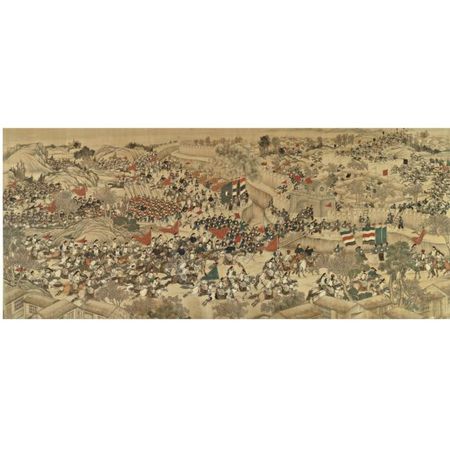




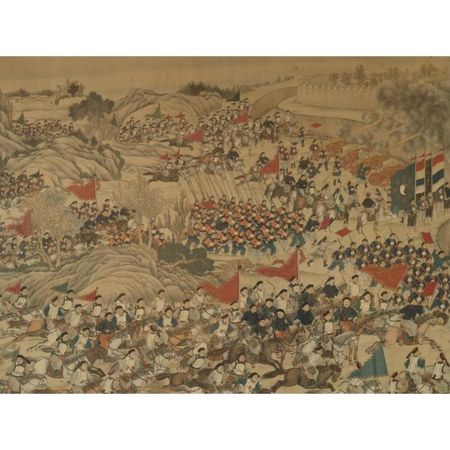




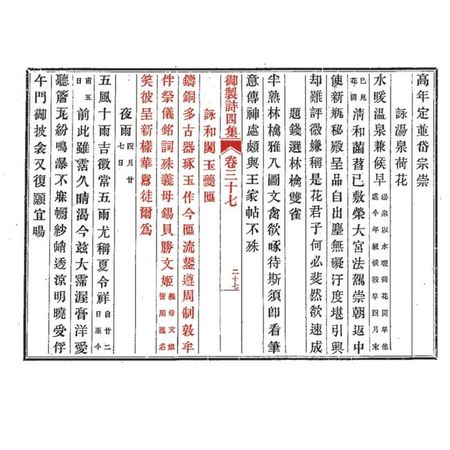
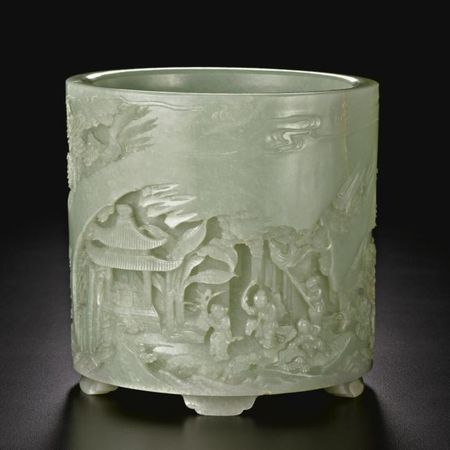

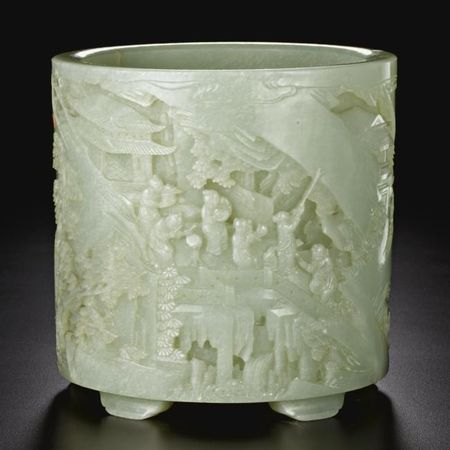











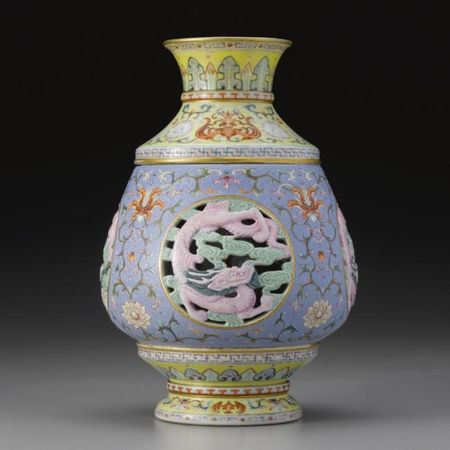


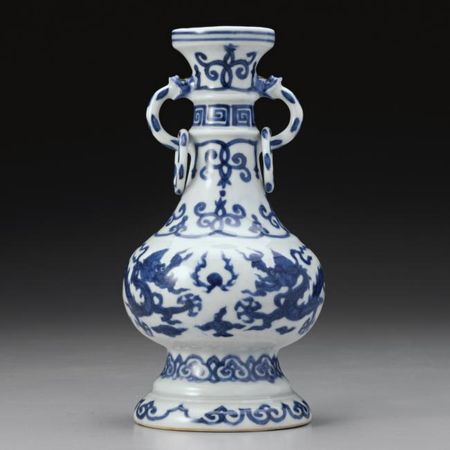



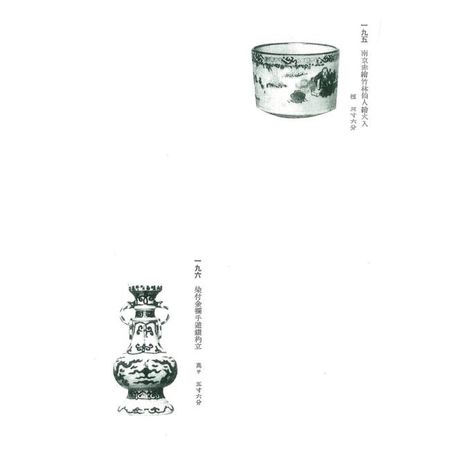












/http%3A%2F%2Fstorage.canalblog.com%2F34%2F01%2F577050%2F66379918_o.jpg)
/http%3A%2F%2Fstorage.canalblog.com%2F04%2F00%2F119589%2F66268897_p.jpg)
/http%3A%2F%2Fstorage.canalblog.com%2F05%2F37%2F119589%2F66268549_p.jpg)
/http%3A%2F%2Fstorage.canalblog.com%2F86%2F30%2F119589%2F66187962_p.jpg)